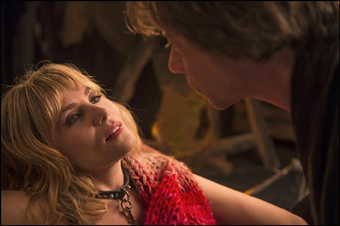![]() To unpack this work, one could say it is a translation and film adaptation of a play, which has within it another play that is a translation and stage adaptation of a scandalous 19th-century novel, Venus in Furs (itself inspired by a painting). David Ives, who wrote the Tony Award-winning play and the screenplay, is a writer who has a love of puzzles. All in the Timing, his ingeniously structured series of short plays, will likely be produced for years and years, and Venus in Fur similarly has much to tempt the audience and artist alike.
To unpack this work, one could say it is a translation and film adaptation of a play, which has within it another play that is a translation and stage adaptation of a scandalous 19th-century novel, Venus in Furs (itself inspired by a painting). David Ives, who wrote the Tony Award-winning play and the screenplay, is a writer who has a love of puzzles. All in the Timing, his ingeniously structured series of short plays, will likely be produced for years and years, and Venus in Fur similarly has much to tempt the audience and artist alike.
Temptation is at the play’s heart, in fact. In an empty theater, Thomas (Mathieu Amalric) is in the middle of a phone call, bemoaning the lack of talent that just auditioned for his play. It seems he was looking for a woman with a capital W, possessor of an indefinable quality, which might only be known when seen. Enter Vanda, a fast-talking gum-chewing actress who just happens to share the name of the woman in Thomas’s play. She also just happens to have a vintage costume for it, a copy of the unpublished script, and to have it all memorized.
There is, obviously, more than meets the eye with Vanda, and the play’s central game involves provoking Thomas to get to the bottom of her, which sounds appropriately naughty for this sex-infused dialogue. At first, Thomas dismisses Vanda’s entreaties for an audition, but for an hour and a half he becomes increasingly submissive.
Or does he? Who has more power, the one who orders or the one who obeys? The cat and mouse onstage is cleverly mirrored by the way Polanski toys with the audience. The first half lacks atmosphere, with no more danger than two kids putting on a show on a rainy afternoon. But the mood develops rapidly in the final third, with evocative lighting and music and camerawork raising the stakes and turning the piece into a devilish confection.
Still, the text undercuts itself. Thomas and Vanda will be in the middle of rehearsing a scene when one or the other will drop the act and criticize the writing, or challenge the meaning, until eventually it becomes difficult to be invested in the dialogue at all. But along the way, the story raises plenty of questions about dominance, sexism, and psychology. The viewer is then left alone to provide answers, with the bizarre actions of the last 10 minutes resisting easy interpretation. Venus in Fur makes you want to turn to the person next to you and say, “What do you think just happened?” And in terms of graphic content, it’s relatively tame. If ever there were a sado-masochistic movie fit for water cooler chat, this is it.
Fitting, since the appeal of the 1870 novel, according to Thomas, is part nostalgia for a time when “conversation itself was erotic.” Whether or not Venus in Fur is seen as such may depend on the viewer. Emmanuelle Seigner, Roman Polanski’s wife, is nearly 20 years older than the actress who originated Vanda. Her interpretation may be more worldly wise, but at times her attempts at seduction feel too calculated.
Furthermore, something may be lost in translating this from English to French. Vanda is supposed to make a surprising transformation when she begins performing—from dumb blonde to diva—but to an American ear, the difference in her two personas is subtle, certainly not enough to provoke the eye-widening response it gets from Thomas (and Amalric’s large eyes are used to great effect throughout).
Yet Seigner is mysterious enough to capture Vanda’s potential to actually be Venus herself, the goddess come to Earth to punish an erring man. That she does so is this adaptation’s greatest strength, and provides its most lingering images.







Leave A Comment